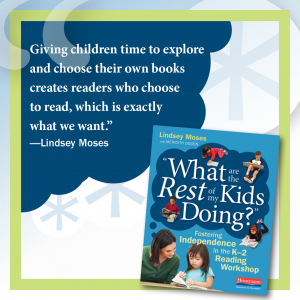
Adapted from "What Are The Rest of my Kids Doing?" Fostering Independence in the K--2 Reading Workshop, by Lindsey Moses and Meridith Ogden
Partner reading is important for many reasons. Literacy is a socially constructed activity involving reading, writing, speaking, listening, viewing, and visually representing. Reading together and talking about books can provide partners with enriching experiences, thinking, and conversation that would not take place while reading independently. In addition to the motivation, engagement, and social aspects, Rogoff (1990) documented interactions between partners that led to each child achieving a higher level of understanding than working by themselves. This could be due to the type of talk surrounding partner reading. Brown (2006) found five major themes of talk occurred during partner reading time in second grade: organizational, disputational, word strategy, meaning making, and personal talk. All of these, except personal talk, supported partner reading.
(Interested in downloading a free sample chapter of "What Are The Rest of my Kids Doing?"? Follow this link to learn more)
Partner selection and instructional support influence talk and success in partner reading. Meisinger and colleagues (2004) found that students who chose their own partner were more successful with social cooperation (instrumental support, emotional support, and conflict management) than when the partner was chosen by the teacher. However, if neither child had the skills to support the reading and/or no one needed support, their time off task increased. The authors also recommended avoiding similar-ability partnerships. This was supported by other research suggesting partnering students of moderately different abilities was ideal (Rogoff 1990; Topping 1989). However, other research and books recommend partnering students at the same reading level (Calkins 2000; Collins 2004; Griffin 2002).
 In addition to reading abilities, choice, and personality, instruction related to interactions, coaching, and conversations plays an important role in the success of partner reading experiences. Students have stronger instrumental support, emotional support, and conflict management (social cooperation) when teachers provide basic support or scripts for coaching and partner interactions in the beginning of the year. Students who receive elaborate or no instruction are associated with poorer social cooperation, showing that students needed modeling and continued support on deepening their interactions with partners and texts, but too much scripting or instruction might stifle their opportunities for flexible talk (Meisinger et al. 2004).
In addition to reading abilities, choice, and personality, instruction related to interactions, coaching, and conversations plays an important role in the success of partner reading experiences. Students have stronger instrumental support, emotional support, and conflict management (social cooperation) when teachers provide basic support or scripts for coaching and partner interactions in the beginning of the year. Students who receive elaborate or no instruction are associated with poorer social cooperation, showing that students needed modeling and continued support on deepening their interactions with partners and texts, but too much scripting or instruction might stifle their opportunities for flexible talk (Meisinger et al. 2004).
• • •
Optimizing Partnerships for Collaborative Independence and Growth
Because the research on ideal partner pairings was mixed (Rogoff 1990; Topping 1989 vs. Calkins 2000; Collins 2004; Griffin 2002), Lindsey and Meridith created multiple partnerships throughout the year: same ability level, slightly different levels, and choice partners. There were periods of only one type of partnership and other periods where we altered partners (A partners, B partners, and so on) depending on their goals for partner reading that day.
Lindsey and Meredith wanted to maximize the benefit of partner reading by encouraging students to support each other in the reading process, and promoted shared responsibility in coaching using strategies that were introduced to the whole group.
The authors offer these steps as a reading partner pre-assessment:
-
Assign partners at approximately the same reading level.
-
Have students find a space and read with a partner for ten minutes.
-
Observe and take notes about reading behaviors (What are they doing? Who is reading? How are they positioned? How do they take turns? Whose books are they reading? What do they do when they get stuck on a word?)
-
Bring them together and discuss their partner reading experience
-
Use questions from the observations to expand and document conversation
♦ ♦ ♦
You can learn more about "What Are The Rest of my Kids Doing?" by downloading a free sample chapter at Heinemann.com.
♦ ♦ ♦
 Lindsey Moses is an assistant professor of literacy education at Arizona State University. A former elementary teacher, Lindsey works with classroom teachers around the country supporting the implementation of effective literacy instruction in diverse settings. Her research focuses on elementary literacy instruction and English learners. Lindsey is the coauthor of Comprehension and English Language Learners and author of Supporting English Learners in the Reading Workshop, which provides research-based, teacher-tested instruction and differentiation ideas that facilitate success for diverse learners.
Lindsey Moses is an assistant professor of literacy education at Arizona State University. A former elementary teacher, Lindsey works with classroom teachers around the country supporting the implementation of effective literacy instruction in diverse settings. Her research focuses on elementary literacy instruction and English learners. Lindsey is the coauthor of Comprehension and English Language Learners and author of Supporting English Learners in the Reading Workshop, which provides research-based, teacher-tested instruction and differentiation ideas that facilitate success for diverse learners.
 Meridith Ogden has worked as a first and second-grade classroom teacher in the greater Phoenix area for the past twelve years. She is currently working as a first-grade demonstration teacher in the Paradise Valley Unified School District, where she shares her passion for Reading Workshop with other educators.
Meridith Ogden has worked as a first and second-grade classroom teacher in the greater Phoenix area for the past twelve years. She is currently working as a first-grade demonstration teacher in the Paradise Valley Unified School District, where she shares her passion for Reading Workshop with other educators.


